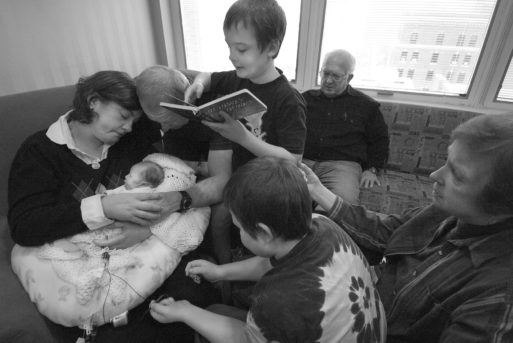This week SevenPonds continues our discussion with Chicago-based documentary photographer Todd Hochberg, the owner of Touching Souls Bereavement Photography. Among other things, Todd takes photographs of babies who are dying or have died so that their families will have a way to remember them. When babies are born dead or die a few hours after birth, parents often don’t have any concrete way to remember their child. The pictures Todd takes are instrumental in helping families through their bereavement.

Todd Hochberg
© Cheri Eisenberg
Debra: How long does your work with families last?
Todd: Sometimes a few hours, sometimes a few days. I worked with one family for three years. In addition to taking photographs of babies who are dying or have died, I also take photographs of older children who have a terminal illness. I may follow them for months or years.
Debra: How do the families of older children respond to the photographs?
Todd: Very positively. I worked with one family, for instance, who had made the difficult decision to remove their child from life support. The mother, especially, was second-guessing herself. When she saw the pictures of the last few hours of her daughter’s life, she said, “You can see in the pictures how sick she really was. It was time for her to go.”
Debra: When you take your photographs, do siblings ever participate?
Todd: Yes. Older siblings are often very curious about and interested in interacting with and documenting the story of the baby. After all, they were expecting to have a new baby brother or sister. A picture of them holding or touching the baby is a concrete object to keep the baby alive in their memories.
Debra: What do you do when the baby is born with birth defects or if there is decomposition?
Todd: I’m kind of a purist, and I do not retouch the photographs. When I’m taking pictures, I may choose angles of view that de-accentuate the problem. My photographs are all in black and white, which ameliorates discoloration of the skin. I always take cues from the parents. Some of them want to remember the baby exactly as he or she was. Others would prefer to forget the more disturbing parts.

Carolyn and Brian Schroeder hold Anna as Liam, age 7, reads a children’s story, “The Runaway Bunny”, to her. James, another sibling and grandparents are also present as the family says goodbye to Anna.
©ToddHochberg
Debra: Why do you think these pictures mean so much to families?
Todd: The time of the death, when I’m usually taking photographs, is often fraught with intensity and emotion. These two factors can make it difficult to form new memories. Days or weeks later, when things calm down a little, the parents may not remember aspects of their experiences and details of what their babies looked like. When I take photographs of babies who are dying or have died, I help the parents recapture that memory.
Debra: How do you handle the intensity of your work?
Todd: I have many friends, and I reach out to them to process what I’ve experienced. I also enjoy cycling for exercise and emotional release. But the truth is that I have been doing this long enough to learn to let my feelings wash through me. I can be emotionally present when I’m with a family and let go of all the intensity when our interaction is finished.
Debra: Todd, thank you so much for taking the time to talk to me today, and thank you for the amazing work you do!
Todd: Thank you, Debra. I’ve enjoyed talking to you.
If you missed part one of our interview with Todd, please catch up here.

 How Can Photographs of Babies Who are Dying or Have Died Help Families Heal?
How Can Photographs of Babies Who are Dying or Have Died Help Families Heal?


 The Spiritual Symbolism of Cardinals
The Spiritual Symbolism of Cardinals

 Flawed Kidney Function Test Discriminated Against Black Patients
Flawed Kidney Function Test Discriminated Against Black Patients














